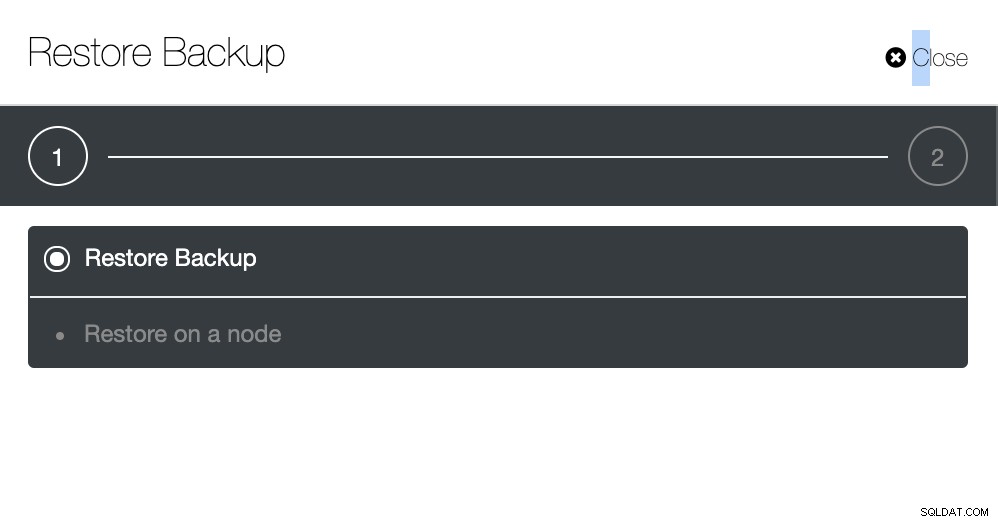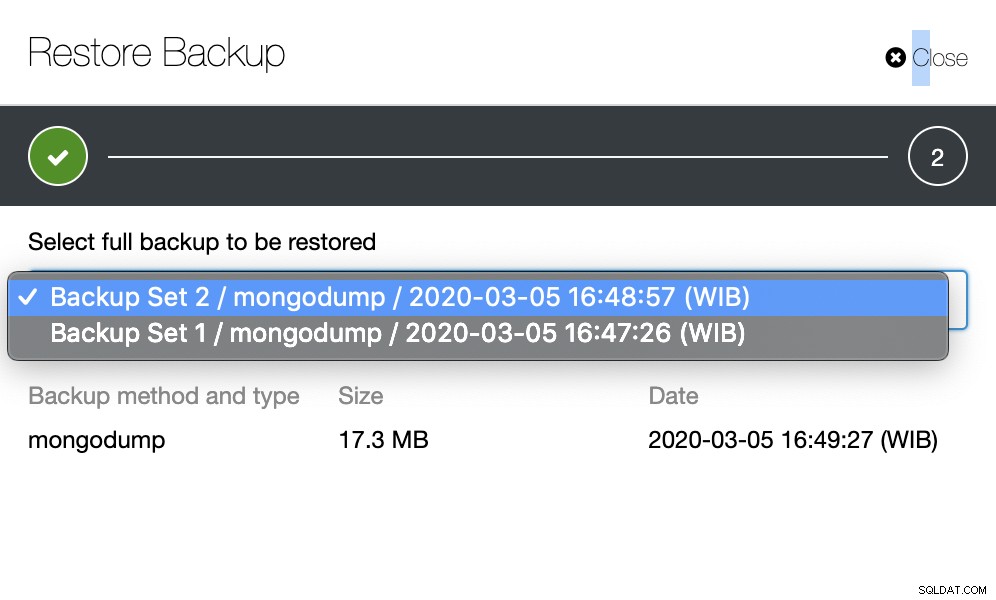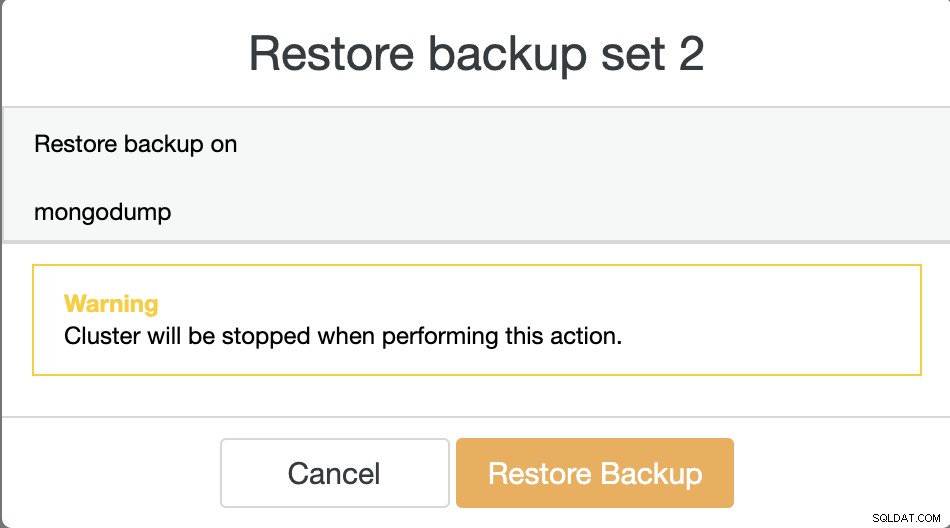データベースのバックアップを保持することは、本番環境で最も重要なタスクの1つです。これは、データを安全に保つために他の場所にデータをコピーするプロセスです。これは、データベースの破損や修復できないほどのデータベースのクラッシュなどの緊急事態からの回復に役立ちます。
リカバリとは別に、バックアップを使用して、本番データベースを模倣し、別の環境でアプリケーションをテストしたり、本番データベースでは実行できないものをデバッグしたりすることもできます。
>データベースに組み込まれているツール(mysqldump、mongodump、pg_dumpなど)を使用した論理バックアップから、サードパーティツール(例:mysqldump)を使用した物理バックアップまで、実装できるデータベースバックアップにはさまざまな方法があります。 xtrabackup、barman、pgbackrest、mongodb一貫性のあるバックアップ)。
どの方法を使用するかは、多くの場合、復元方法によって決まります。たとえば、誤ってテーブルまたはコレクションを削除したとします。思われるかもしれませんが、それは起こります。したがって、回復するための最速の方法は、データベース全体を復元するのではなく、そのテーブルまたはコレクションだけを復元することです。
Mongodbでのバックアップと復元
Mongodumpとmongorestoreは、MongoDBで使用される論理バックアップ用のツールであり、MySQLではmysqldump、PostgreSQLではpg_dumpの一種です。 MongoDBをインストールすると、mongodumpおよびmongorestoreユーティリティが含まれ、データをBSON形式でダンプします。 Mongodumpはデータベースを論理的にダンプファイルにバックアップするために使用され、mongorestoreは復元操作に使用されます。
mongodumpおよびmongorestoreコマンドは、多くのオプションがありますが、簡単に使用できます。
以下に示すように、特定のデータベースまたはコレクションをバックアップできます。 oplogを含めることで、POSスナップショットを作成することもできます。
[email protected]:~# mongodump --help
Usage:
mongodump <options>
Export the content of a running server into .bson files.
Specify a database with -d and a collection with -c to only dump that database or collection.
See http://docs.mongodb.org/manual/reference/program/mongodump/ for more information.
general options:
--help print usage
--version print the tool version and exit
verbosity options:
-v, --verbose=<level> more detailed log output (include multiple times for more verbosity, e.g. -vvvvv, or specify a numeric value, e.g. --verbose=N)
--quiet hide all log output
connection options:
-h, --host=<hostname> mongodb host to connect to (setname/host1,host2 for replica sets)
--port=<port> server port (can also use --host hostname:port)
kerberos options:
--gssapiServiceName=<service-name> service name to use when authenticating using GSSAPI/Kerberos ('mongodb' by default)
--gssapiHostName=<host-name> hostname to use when authenticating using GSSAPI/Kerberos (remote server's address by default)
ssl options:
--ssl connect to a mongod or mongos that has ssl enabled
--sslCAFile=<filename> the .pem file containing the root certificate chain from the certificate authority
--sslPEMKeyFile=<filename> the .pem file containing the certificate and key
--sslPEMKeyPassword=<password> the password to decrypt the sslPEMKeyFile, if necessary
--sslCRLFile=<filename> the .pem file containing the certificate revocation list
--sslAllowInvalidCertificates bypass the validation for server certificates
--sslAllowInvalidHostnames bypass the validation for server name
--sslFIPSMode use FIPS mode of the installed openssl library
authentication options:
-u, --username=<username> username for authentication
-p, --password=<password> password for authentication
--authenticationDatabase=<database-name> database that holds the user's credentials
--authenticationMechanism=<mechanism> authentication mechanism to use
namespace options:
-d, --db=<database-name> database to use
-c, --collection=<collection-name> collection to use
uri options:
--uri=mongodb-uri mongodb uri connection string
query options:
-q, --query= query filter, as a JSON string, e.g., '{x:{$gt:1}}'
--queryFile= path to a file containing a query filter (JSON)
--readPreference=<string>|<json> specify either a preference name or a preference json object
--forceTableScan force a table scan
output options:
-o, --out=<directory-path> output directory, or '-' for stdout (defaults to 'dump')
--gzip compress archive our collection output with Gzip
--repair try to recover documents from damaged data files (not supported by all storage engines)
--oplog use oplog for taking a point-in-time snapshot
--archive=<file-path> dump as an archive to the specified path. If flag is specified without a value, archive is written to stdout
--dumpDbUsersAndRoles dump user and role definitions for the specified database
--excludeCollection=<collection-name> collection to exclude from the dump (may be specified multiple times to exclude additional collections)
--excludeCollectionsWithPrefix=<collection-prefix> exclude all collections from the dump that have the given prefix (may be specified multiple times to exclude additional prefixes)
-j, --numParallelCollections= number of collections to dump in parallel (4 by default) (default: 4)
--viewsAsCollections dump views as normal collections with their produced data, omitting standard collectionsmongorestoreコマンドには多くのオプションがあり、必須オプションはホスト、ポート、認証などの接続オプションに関連しています。コレクションを並列に復元するために使用される-j、特定のコレクションに使用される-cまたは--collection、特定のデータベースを定義するために使用される-dまたは--dbなど、他のパラメーターがあります。 mongorestoreパラメータのオプションのリストは、ヘルプを使用して表示できます:
[email protected]:~# mongorestore --help
Usage:
mongorestore <options> <directory or file to restore>
Restore backups generated with mongodump to a running server.
Specify a database with -d to restore a single database from the target directory,
or use -d and -c to restore a single collection from a single .bson file.
See http://docs.mongodb.org/manual/reference/program/mongorestore/ for more information.
general options:
--help print usage
--version print the tool version and exit
verbosity options:
-v, --verbose=<level> more detailed log output (include multiple times for more verbosity, e.g. -vvvvv, or specify a numeric value, e.g. --verbose=N)
--quiet hide all log output
connection options:
-h, --host=<hostname> mongodb host to connect to (setname/host1,host2 for replica sets)
--port=<port> server port (can also use --host hostname:port)
kerberos options:
--gssapiServiceName=<service-name> service name to use when authenticating using GSSAPI/Kerberos ('mongodb' by default)
--gssapiHostName=<host-name> hostname to use when authenticating using GSSAPI/Kerberos (remote server's address by default)
ssl options:
--ssl connect to a mongod or mongos that has ssl enabled
--sslCAFile=<filename> the .pem file containing the root certificate chain from the certificate authority
--sslPEMKeyFile=<filename> the .pem file containing the certificate and key
--sslPEMKeyPassword=<password> the password to decrypt the sslPEMKeyFile, if necessary
--sslCRLFile=<filename> the .pem file containing the certificate revocation list
--sslAllowInvalidCertificates bypass the validation for server certificates
--sslAllowInvalidHostnames bypass the validation for server name
--sslFIPSMode use FIPS mode of the installed openssl library
authentication options:
-u, --username=<username> username for authentication
-p, --password=<password> password for authentication
--authenticationDatabase=<database-name> database that holds the user's credentials
--authenticationMechanism=<mechanism> authentication mechanism to use
uri options:
--uri=mongodb-uri mongodb uri connection string
namespace options:
-d, --db=<database-name> database to use when restoring from a BSON file
-c, --collection=<collection-name> collection to use when restoring from a BSON file
--excludeCollection=<collection-name> DEPRECATED; collection to skip over during restore (may be specified multiple times to exclude additional collections)
--excludeCollectionsWithPrefix=<collection-prefix> DEPRECATED; collections to skip over during restore that have the given prefix (may be specified multiple times to exclude additional prefixes)
--nsExclude=<namespace-pattern> exclude matching namespaces
--nsInclude=<namespace-pattern> include matching namespaces
--nsFrom=<namespace-pattern> rename matching namespaces, must have matching nsTo
--nsTo=<namespace-pattern> rename matched namespaces, must have matching nsFrom
input options:
--objcheck validate all objects before inserting
--oplogReplay replay oplog for point-in-time restore
--oplogLimit=<seconds>[:ordinal] only include oplog entries before the provided Timestamp
--oplogFile=<filename> oplog file to use for replay of oplog
--archive=<filename> restore dump from the specified archive file. If flag is specified without a value, archive is read from stdin
--restoreDbUsersAndRoles restore user and role definitions for the given database
--dir=<directory-name> input directory, use '-' for stdin
--gzip decompress gzipped input
restore options:
--drop drop each collection before import
--dryRun view summary without importing anything. recommended with verbosity
--writeConcern=<write-concern> write concern options e.g. --writeConcern majority, --writeConcern '{w: 3, wtimeout: 500, fsync: true, j: true}'
--noIndexRestore don't restore indexes
--noOptionsRestore don't restore collection options
--keepIndexVersion don't update index version
--maintainInsertionOrder preserve order of documents during restoration
-j, --numParallelCollections= number of collections to restore in parallel (4 by default) (default: 4)
--numInsertionWorkersPerCollection= number of insert operations to run concurrently per collection (1 by default) (default: 1)
--stopOnError stop restoring if an error is encountered on insert (off by default)
--bypassDocumentValidation bypass document validation
--preserveUUID preserve original collection UUIDs (off by default, requires drop)MongoDBで特定のコレクションを復元するには、mongorestoreのパラメーターコレクションを使用します。注文データベースがあると仮定します。注文データベース内には、以下に示すようなコレクションがいくつかあります。
my_mongodb_0:PRIMARY> show dbs;
admin 0.000GB
config 0.000GB
local 0.000GB
orders 0.000GB
my_mongodb_0:PRIMARY> use orders;
my_mongodb_0:PRIMARY> show collections;
order_details
orders
stock注文データベースのバックアップはすでにスケジュールされており、同じサーバー内の新しいデータベースorder_newに在庫コレクションを復元したいと考えています。オプション--collectionを使用する場合は、mongorestoreのパラメータとしてコレクション名を渡す必要があります。コレクションファイルへのパスを指定しなかった場合は、オプション--nsInclude={db}。{collection}を使用できます。 。
[email protected]:~/dump/orders# mongorestore -umongoadmin --authenticationDatabase admin --db order_new --collection stock /root/dump/orders/stock.bson
Enter password:
2020-03-09T04:06:29.100+0000 checking for collection data in /root/dump/orders/stock.bson
2020-03-09T04:06:29.110+0000 reading metadata for order_new.stock from /root/dump/orders/stock.metadata.json
2020-03-09T04:06:29.134+0000 restoring order_new.stock from /root/dump/orders/stock.bson
2020-03-09T04:06:29.202+0000 no indexes to restore
2020-03-09T04:06:29.203+0000 finished restoring order_new.stock (1 document)
2020-03-09T04:06:29.203+0000 done以下に示すように、order_newデータベースのコレクションを確認できます:
my_mongodb_0:PRIMARY> use order_new;
switched to db order_new
my_mongodb_0:PRIMARY> show collections;
stockClusterControlでmongodumpを使用して復元する方法
ClusterControlを介したバックアップダンプの復元は簡単です。バックアップを復元するには、2つの手順が必要です。バックアップスケジュールを有効にした場合、リストには多くのバックアップファイルが含まれます。バックアップに関するいくつかの情報が非常に役立ちます。たとえば、バックアップが完了/失敗したかどうかを示すバックアップのステータス、バックアップの実行方法、データベースのリスト、およびダンプのサイズ。 ClusterControlを介してMongoDBデータを復元する手順は次のとおりです:
以下に示すように、プロンプトに従ってバックアップをノードに復元します...



